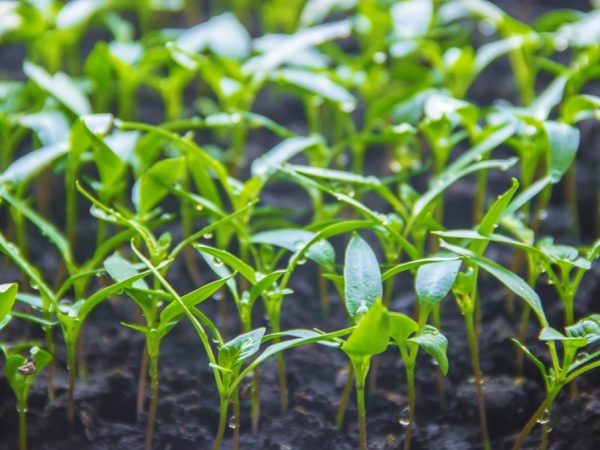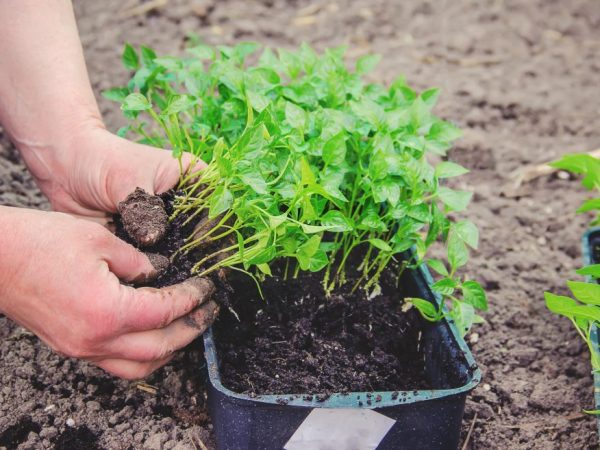Features of sowing seedlings of eggplants and peppers
Some crops require pre-sowing of seedlings indoors before transplanting into open ground. Often these are varieties that grow well in southern regions, but can freeze out in the spring in areas with cooler climates. Such capricious plants include eggplant and pepper seedlings, which require special conditions.

Features of sowing seedlings of eggplants and peppers
Selection and preparation of seeds
In order not to waste time on bad seeds, a germination test is carried out in advance. To do this, take 10 seeds of the selected varieties, wrap them in cloth and put them in water for a day at a temperature of 25 ° C. After that, the seeds are placed on a flat surface in a place where the heat is maintained at 30 ° C. The fabric is constantly moisturized. After 3 or 4 days, the seeds begin to hatch, then their potential is assessed. 5 actively reacting seeds of each crop indicate good selection and readiness for sowing.
After such a simple selection, the seeds of peppers and eggplants for seedlings are disinfected. To do this, prepare a strong solution of manganese (potassium permanganate). Soaking crops in it lasts 30-40 minutes. Further, after rinsing with clean water, the nutrient solution is used. There are several recipes for this liquid per 1 liter of water:
- 1/4 capsule of trace elements or 1/3 tsp. mineral fertilizer;
- 1/3 tsp nitrophosphate and 1/2 tsp. wood ash;
- 1 tsp liquid cow manure and 1/3 tsp. nitrophosphate.
A solution of any composition is brought to a temperature of 25 ° C-28 ° C, planting material is immersed in it for a day, which helps the seeds of pepper and eggplant gain strength and germinate faster. After that, the cloth bags with seeds are washed again and dried on a plate at a temperature of 25 ° C so that they hatch. The germination begins 5-6 days after feeding.
To preserve seedlings in the cold time of the day with soil sowing, hardening is used. It is carried out for 5-6 days. For this, a change in air temperature is used. On the first day after feeding, the seeds are placed on the lower shelf of the refrigerator for 2 days (at 2 ° C-5 ° C heat), for 1-2 days the tissue is kept in a warm place with a temperature of 18 ° C and returned to the refrigerator for the last 2 days. All this time, the moisture of the seeds is maintained.
Sowing preparation
The timing of planting pepper and eggplant seeds depends on the climatic conditions where crops will grow in open ground in central Russia. It is important not to plant peppers and eggplants on seedlings too early: this will lead to their overgrowth. It is also impossible to delay sowing: this is how the right time is missed for adapting the plant to planting. Sowing pepper and eggplant seeds for seedlings in February or the first half of March is considered ideal, then the growing period will be reduced to 90-100 days.
From the second half of March, sowing peppers and eggplants is not recommended, unless they are planned to be planted under a greenhouse cover in the future.
To determine favorable days for planting sprouts, use the lunar calendar.According to him, crops are sown at the time when the first phase of the moon is in the sign of Aries, Scorpio, Libra or Sagittarius. Lucky periods are between January 17 and 20, February 1 and 13, March 11 and 13, March 16-17. They fall every year on the waxing moon. It is customary to plant crops at this time.

We sit on the growing moon
Soil selection
In properly selected soil, under all comfortable conditions, pepper seeds germinate in 7-15 days, eggplant seeds - in 5-10 days. For these crops, a light, low acidity soil is ideal. It makes sense to plant seeds in a substrate, which is created by mixing a number of components:
- special soil for vegetable seedlings, and a little sand;
- 3 parts of rotted manure and 2 parts of turf;
- 2 parts of peat, 2 parts of humus, part of fine wood dust;
- 2 parts of humus and part of sod land;
- 2 parts of garden land, 2 parts of rotted manure and part of river washed sand.
Preparing the soil includes filling it with the necessary elements. Be sure to add fertilizer to the substrate in order to immediately organize the delivery of nutrients to the plants. To do this, use wood ash in the amount of 2 tbsp. l. or 1 tbsp. l. superphosphate on a bucket of soil. All this mixture is well mixed and distributed in containers.
Sowing seeds and organizing the site
Containers for sowing seedlings should be as convenient as possible, designed for the individual cultivation of each plant. To do this, take small cups for seedlings or peat pots. It is recommended to plant crops so that you do not have to pick them: it can damage the delicate roots of crops, which will slow down their growth and development. It is better to plant different varieties in separate containers so as not to confuse them when transferred to open ground.
The containers are filled with earth to a depth of at least 10 cm. Then it is watered with a light solution of potassium permanganate for disinfection.
After 10-12 hours, depressions of about 1.5-2 cm are made in each container, into which 1-2 seeds are sown. It is easily covered with soil and watered with warm water, better thawed. It is better to plant the seeds in lightly compressed soil.
There are some features that help to grow a good harvest from seeds:
- pots for peppers should have a diameter of 4 cm, for eggplants - 5 cm;
- as a fertilizer, ammonium nitrate is used in the amount of 15 g or potassium sulfate in the calculation of 50 g per bucket of soil;
- if the seedlings are in long boxes, they make thin grooves to a depth of 1.5 cm, with a distance of 5 cm between them, it is better to plant the seeds every 2 cm.
Seedlings love constant diffused light, therefore, immediately after planting, containers are placed on the south side of the house on the windowsills or closer to the windows. Optimal daylight hours for plants should last from 8 am to 8 pm. To compensate for the lack of light, weak table lamps are used, located at some distance, so as not to overheat and not damage the sprouts.
Maintaining the temperature regime is mandatory. Until the first shoots appear, it is better to adhere to a heat level within the range of 25 ° С-28 ° С. The cultivation is carried out at a temperature of 22 ° C-25 ° C. At night, it is permissible to lower the temperature to 17 ° C-18 ° C: this will harden the sprouts, and it will be easier to plant them in open soil. Make sure that the plants are not exposed to drafts.
Seedling care
The best basis for the future harvest from strong and hardy varieties is good care of seedlings of peppers and eggplants. After the emergence of seedlings on the 4th day, the first watering is carried out. It is unnecessary to do this earlier, since during the first day the earth retains moisture. It is also not worth overdrying the soil: the plants are moisture-loving. If the soil dries out and cracks too quickly, the containers with the seedlings are moved to a cooler place and the air is additionally humidified by spraying.
Water for irrigation is used thawed, boiled or settled.After the appearance of the first leaves, the earth is moistened with a spray bottle every 5 days. With about the same regularity, the soil is loosened to provide air access to the roots and not harm them. This action is also the prevention of stagnation of water in the ground, which the varieties do not like.
Care for pepper and eggplant seedlings includes fertilizing seedlings.
Weak leaves and stems of seedlings indicate a lack of nutrients in the soil. To remedy the situation and help the crops grow green mass, nitrogen-containing fertilizers are added. In the future, growth stimulants are introduced into the soil, which improve the metabolism of nutrients.
Overly elongated plants signal a lack of light. In this case, the daylight hours are shortened, but the illumination of the seedlings is intensified.
Conclusion
The process of preparing for sowing peppers and eggplants does not take much time, but the correct fulfillment of all conditions ensures a good number of shoots and strong plants that help to grow a rich harvest in the future.
It is necessary to maintain a sequence of actions and pay maximum attention to caring for the plant. You can plant ready-made seedlings in open ground after 50-60 days from the moment of germination at home.


